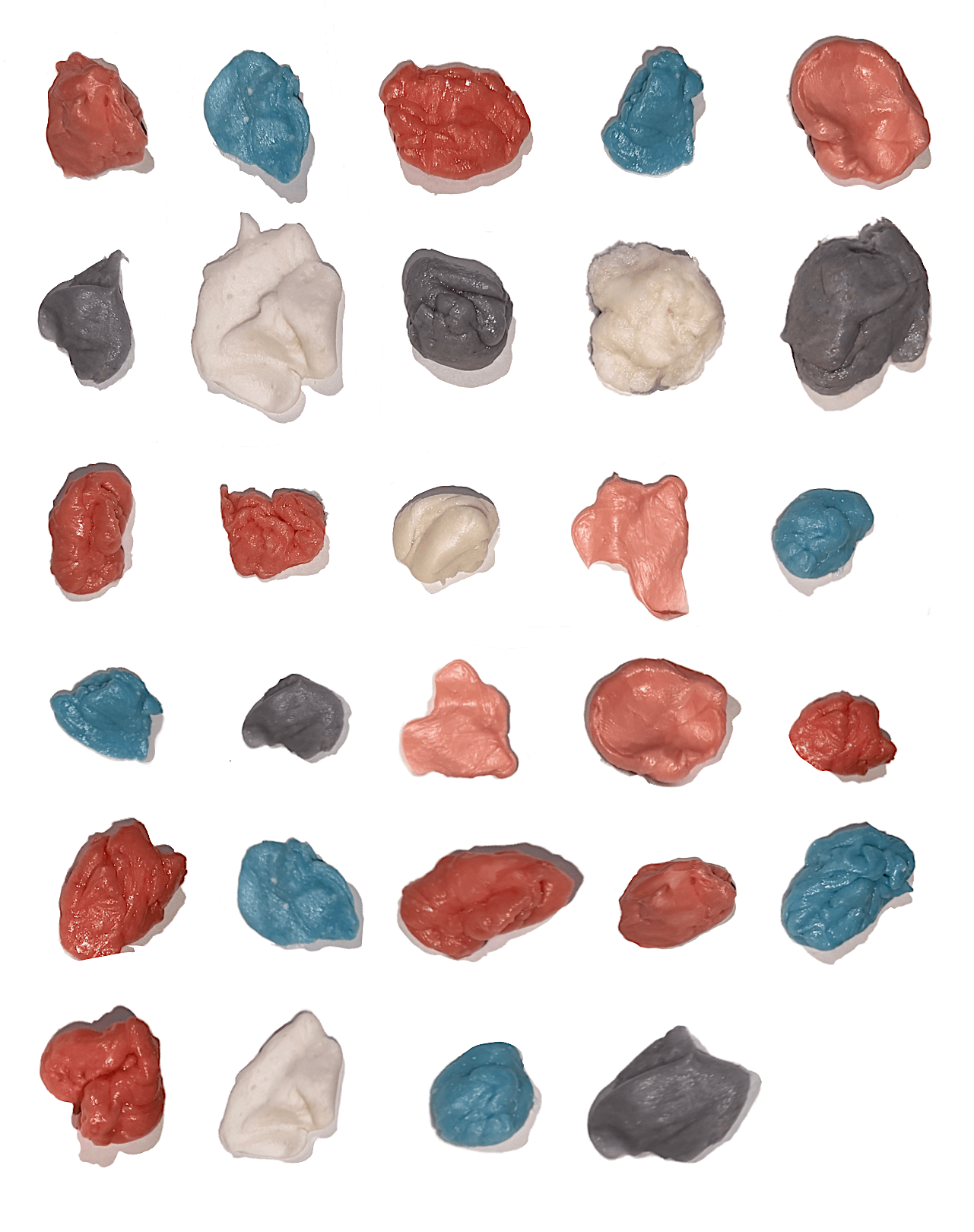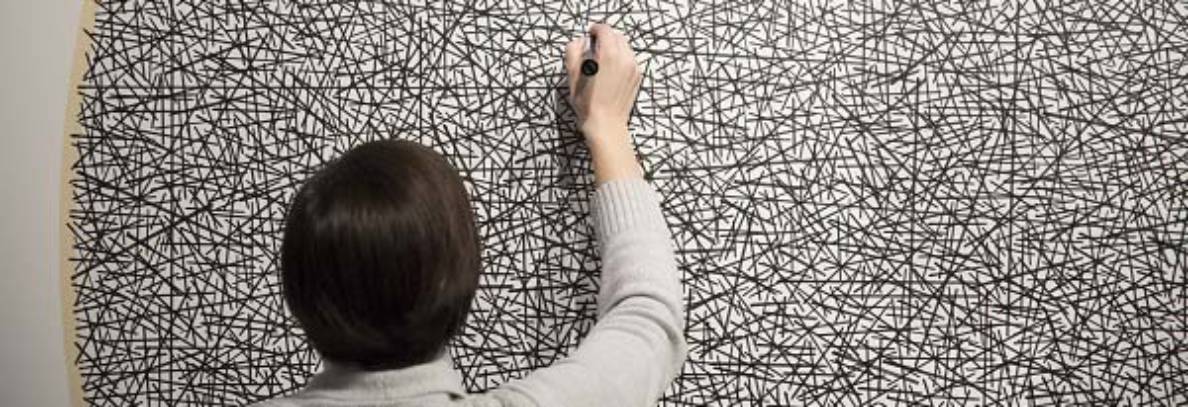Kilometer Project
After briefly examining the work of artist Jenny Holzer, I grew interested in knowing the degree to which viewers effectively engage with these types of message-oriented installations. Specifically, I was curious to determine if observers derive any value from these works, or if they completely overlook them in the first place. In order to explore this concept, I developed a series of cards designed to travel a precise distance of 1 km, using the receivers of these cards as the vessels for their transit.

Knowing that the walking distance from my house to the university is approximately a kilometer in length, I began by calculating where the exact distance would situate me. Through mathematical calculation, I was able to establish that a kilometer would equate approximately 1,450 steps, taking into consideration my height and average walk speed. I then left my house and walked straight towards the university to see where this many steps would take me. By sheer luck, this distance ended up bringing me to the intersection of Gordon and Stone road, directly next to the university’s well known gryphon statue.
I pinpointed this as my 1 km mark, and established the location as where the cards had to be brought to for the experiment to be successful.
I then designed a simple card to be created in 11 copies, and which were distributed to, respectively, 11 different households in my neighbourhood.


The cards draw direct inspiration from Jenny Holzer’s projections, replicating the simple, text-only design that characterize much of her work. Similarly, the grain of the print, although not initially intentional, created an interesting factor to interpellate viewers. Further, the cards were created with straightforward yet not overly specific instructions, reproducing the sense of mystery that makes Holzer’s work effective.
The households in which the cards were distributed to were chosen very specifically, taking into consideration only people that lived away from me, and on the same route that I took to get to the 1 km mark. Individuals would be anywhere from 800 to 200 meters away from the end point. Further, people to which I brought the cards to were individuals that I knew personally, yet had no knowledge of the project I was conducting. To avoid suspicion, these people did not see me bring the card to their doorsteps.
I waited 4 days before going to retrieve any potential cards. As a result, I found that out of the 11 cards I had distributed, only 2 had traveled the 1 km distance and been actually brought to location as asked for.
What struck me the most about this project was holding the cards in my hand after having retrieved them. In my palm was an exact kilometer, a tangible token of the distance traveled. We often imagine a kilometer as a very vague, conceptual, and overall ambiguous thing, because it is. The cards I retrieved represented the exact distance mentioned, having adventured from my house my neighbours’ households, to the statue as intended. But if I ever moved the card from the place it was found, nestled under the statue’s front hind paw, this would mean that it would no longer represent an exact kilometer. I believe this perfectly exhibits the nature of a kilometer, so delicate and cryptic at the same time.

Pipilotti Rist

Pipilotti Rist – Ever Is Over All. 1997
1. Pipilotti Rist’s video installation, Ever Is Over All, presents a striking tableau for the audience, featuring a women walking along a city street, while simultaneously damaging parked cars along her route. Rist incorporates an element of absurdity in this work by presenting things that appear unrealistic or out of context. For example, the women smashes car windows utilizing a flower as her weapon, whilst a police officer walks by, acknowledging her actions with a cheerful salute. While these two occurrences may be improbable in reality, they enhance the intrigue of Rist’s work. Various camera angles, such as frontal, distant, close-up, and side perspectives, are utilized to portray the woman. In this way, Rist is either situating her within the tangible environment of the street, offering a perspective as if one were strolling by, or framing her more centrally, thereby inviting the viewer to engage with her intimate experience and emotions. While the woman is seen in a sticking blue dress and red heels, the colours of the work are deluded with a slight green tinge, and a hazy effect is seen across the screen. Meanwhile, a soft humming sound resonates in the background, enhancing the enigmatic atmosphere of the piece. The work is showcased in conjunction with slow-motion visuals of nature, with the two videos merging in the middle and producing a dream-like effect.
2. Rist’s creations bear a resemblance to modern video culture, as she frequently incorporates a subtle element of chaos into her pieces. This approach effectively captures the audience’s attention, rendering her work both engaging and entertaining. This approach is frequently used in TikTok and YouTube videos. If we reflect on the numerous social media trends that have gained popularity in recent years, we may be quick to classify several of them as “weird,” or “crazy,” seeing that they challenge our societal norms. Further, both Rist’s work and contemporary videos captivate the audience almost instantaneously, drawing them in and creating the impression that one could engage with the content for hours on end. This being said, Rist’s work has an artistic depth that I believe is lacking in many contemporary videos. Her work is meticulously organized, from composition to colour, and is driven by a genuine purpose and meaning. In contrast, most videos on platforms such as TikTok or YouTube have for only aim to entertain, most times rather stupidly, which often leads to us feeling like we have wasted out time watching said videos.

3. Experiencing a day with my shirt worn inside out made me feel strangely vulnerable. I am generally accustomed to avoiding the spotlight, as I tend to be quite reserved and have an aversion to excessive attention. This experiment certainly did the opposite of what was within my comfort level; I suffered from many questioning stares and, on occasion, a few chuckles, which left me feeling rather uneasy. However, I am glad to have successfully navigated this challenge, as it does illustrate the delicate nature of social acceptance. I think that whether this could be considered performance is contingent on the intention behind it. We often say that anything can be art when we say that it is art, and the same applies here. If this was carried out deliberately with the intent to provoke a reaction, I would argue that it qualifies as art. However, if this was simply accidental, there would be no intent behind the piece, and thus it would be more of a mistake than art.
Everyday Gestures
Toronto Field Trip

The artwork that stood out to me the most whilst on my trip to Toronto was Alex Da Corte’s Ear Worm installation at MOCA. What captivated me most about this work was the sensory aspects that can be encountered upon entering the room. The darkness of the space, juxtaposed with the vibrance of neon-coloured lights, and combined with the coming together of audio from the video projections, created an amalgam that was both overstimulating and profoundly exhilarating. In fact, the auditory experience begins before the elevator even opens, with the striking audio reverberating against the door’s very walls, and filling the viewer with initial confusion, or excitement, for what is to come.
Adjusting to the surroundings takes some time, but once habituated, the videos reveal themselves as being equally striking. My thoughts shifted rapidly as I navigated from one film to another, simultaneously trying to see them all at once while also attempting to focus on them independently. At first, I found that the pieces appeared confused; after all, what does a singing witch next to Oscar the Grouch have to do with anything? Then, they seemed strange and grotesque, with the diluted images feeling uncanny. But at last, I was able to appreciate the quality and detail of the work. The fact that Da Costa performs the parts of all characters is remarkable, and the attentiveness that is displayed in creating each set is equally exceptional. Not to mention, the very fact that this work goes on for two full hours with different videos really does goes to show the amount of work that was put into the installation, and the attentiveness to making the viewer have a stimulating experience.
Video Project: Bad Table Manners
Upon observing various video examples related to this project, my partner and I noticed that a large number of them focused on the manipulation of food, often with the intent of eliciting disgust or discomfort in the viewer. This idea captured our interest, and prompted us to delve into the exploration of what aspects of food manipulation contribute to its perceived repulsiveness or abnormality. We notably achieved this by observing unconventional dining etiquette, particularly concentrating on opposing societal norms imposed upon women’s conduct, to construct the most bizarre and disconcerting situations we could possible associate with mealtime.
By representing a table scene, my partner and I aimed to construct a scenario where the viewer could imagine themselves dining in the presence of the person on screen. By positioning the audience as a force who experiences the sensation of having a real time meal with the improperly behaving performer, we were able to achieve the sense of discomfort we desired as an outcome.
Loop
In this video, we aimed to highlight the absurd manipulation of food, particularly by adjusting the framing to concentrate on the plate. This allows the viewer to focus on the action being performed, rather than the person it is being performed by.
One Shot
This video focuses on absurd food manipulation through the utilization of a prop. We framed the video frontally, allowing the viewer to fully engage with Norah’s straight face as she performs a ludicrous action, in order to provoke an even more disconcerting reaction.
Sequence
This video aims to focus on pushing the idea of absurd food manipulation by having the performer bathe in the food.
Audio Project: Bilingualism
In this work, I aimed to investigate the experience of communicating in multiple languages, particularly the confusion that arises during interactions with others. The audio features a conversation simultaneously presented in both French and English, creating a disordered and challenging listening experience. This arrangement is intended to reflect the confusion I frequently encounter when switching between the two languages, often mixing vocabulary from one with that of the other. With a concentrated effort, the listener can comprehend and appreciate the dialogue of each language individually. This illustrates the externalized conversation perceived by others, despite the internal struggle of the speaker.
Pauline Oliveros: Sonic Meditations
Pauline Oliveros’s Sonic Meditations presents a conceptual framework in which participants collectively engage in the creation of a sonic performance. Specifically, this is done through the processes of creating, imagining, remembering, and listening to a variety of sounds. This heightened awareness of one’s environment fosters an atmosphere that is considered to be both soothing and conducive to positive energy. Oliveros developed this idea in response to her feelings regarding spectators’ omission from musical performances. The intention behind these works is to “[…] eliminate the subject/object or performer/audience dynamic […]” thereby ensuring that all individuals can be integrated into these auditory experiences.
After reading this short article, I became very interested in exploring the auditory experience of Sonic Meditations and determining whether they are indeed as soothing as claimed to be. After conducting some research, I discovered several examples that particularly resonated with me (listed below). To my astonishment, the soft humming, combined with the harmonious blend of voices that nearly resemble a choir, was quite beautiful. Overall, this genuinely proved to be a meditative experience for me, as Oliveros describes it to be.
Tom Kiefer: El Sueño Americano
Upon first encountering Tom Kiefer’s work, El Sueño Americano (The American Dream), one might simply see pictures of mundane, everyday life items. However, these objects collectively form a poignant representation of the discarded possessions of migrants seeking asylum.Kiefer’s work serves as a photographic record of these belongings, which were confiscated near the U.S./Mexico border on the grounds of being deemed either “non-essential” or “potentially lethal.”
I found this work to be extremely heartbreaking. To see these items appearing so forsaken, evokes a deep sense of sorrow. Although they are quite ordinary, they carry immense significance, both in what they represent and in the value they held for the individuals who abandoned them. This sentiment was particularly evident with items like children’s backpacks and toys, which, despite the tragedies they have undoubtedly witnessed, exude an air of joy. Observing these objects was particularly challenging, given the difficult circumstances the world is presently facing; however, I do believe it serves as a stark reminder for the viewers, and one we should not forget.
Conceptual Portrait: Chewed Away

Ever since I was a child, I have suffered from a panic disorder that complicates my day-to-day activities, with attending classes being an especially challenging feat. Although I have adapted to this condition, it still remains a prominent aspect of my reality. To cope with this, I have developed certain strategies which allow me to alleviate the effects of my panic episodes, with the most effective method being the vigorous chewing of gum. For this project, I aimed to photographically document the quantity of gum I chewed over a period of seven school days, in order to assess how I mitigate my academic-related anxiety on a daily basis. In total, I ended up chewing 29 pieces of gum over the course of 10 classes, which encompassed approximately 18 hours of instruction. The daily counts were recorded as follows:
Thursday, November 7 (2 one-hour long lectures): 4 pieces
Friday, November 8 (1 three-hour long lab): 3 pieces
Monday, November 11 (1 one-hour-long lecture): 2 pieces
Tuesday, November 12 (1 one-hour-long lecture): 2 pieces
Wednesday, November 13 (2 three-hour long labs, 1 hour long lecture): 11 pieces
Thursday, November 14 (1 one-hour-long lecture): 3 pieces
Friday, November 15 (1 three-hour long lab): 4 pieces
To complete this work, I proceeded with chewing my gum as I usually would on any given school day. However, every time I tired of a specific piece of gum, instead of throwing it away as I typically would, I rather stored them in a plastic sandwich bag. I labelled each bag with the date so that I could know how much gum I consumed on a given day. The finial photographical documentation puts each gum in order of first to last chewed.
While this may appear to be a rather mundane and simplistic way to approach this project, the final piece proves highly personal. Where one might perceive merely a dull piece of excessively chewed gum, I see the intensity of my chew marks, revealing the fight-or-flight urgency I felt at that moment. Where someone might observe the pale pink hue indicative of a likely bubblegum flavour, I see the once vibrant red of a strawberry flavour, so thoroughly eaten away at that it has become tough and jaw-aching. Most significant for me, however, is that in each chewed fragment, I am able to recognize the precise moment and reason for my being anxious, something only I will ever see.

Following Diane’s recommendation, I ultimately decided to print this image as a poster, to enhance the experience of engaging with this artwork more tangibly. I do agree with the fact that this approach makes the work stand out more, allowing the viewer to engage with the piece in a more direct and immersive manner.
Artist Multiple: Scratched



For my button series, I aimed to convey the passage of time by tangibly capturing the experiences an individual encounters throughout their day. To achieve this, I drew on the concept of rainbow scratch paper, and, on the surface of my pins, applied a medium that can be scored upon friction. In this way, when an individual places the pin on their backpack or clothing and engages in their daily activities, the pins will naturally acquire a distinct roughness that reflects their individual experiences.
In its initial form, the pins are black, and might appear boring or bleak to the viewer. Nevertheless, as they endure the challenges of daily life, a stunning gradient begins to surface, symbolizing the significance of each moment we experience in time. The process of scratching to uncover this image illustrates our engagement with time, and asks the beholder to contemplate whether they have utilized their precious minutes to its fullest potential.

You must be logged in to post a comment.